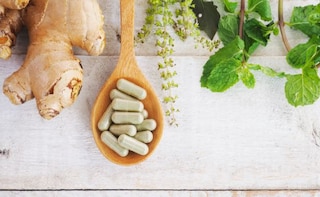When you think 'antibiotics', you immediately think of popping pills. Isn't it? For most part that is true. Antibiotics are medicines prescribed to cure a range of bacterial infections. These work either by killing the bacteria or stopping the bacteria from multiplying. But, did you know that the use of anti-bacterials has been going on since ancient times and much before the chance discovery of Penicillin by Alexander Fleming in 1928 to cure and control bacterial infections?
2. NeemThe Neem tree is a common sight across India. We already know the health benefits of neem. But ever wondered why applying neem paste on your face helps you get rid of pimples? It is because of neem’s anti-bacterial properties! Neem and neem oil have been recommended in Ayurveda for their purifying abilities. Neem can be eaten as well as applied locally. Though, consumption for a longer duration must be done only after consulting a health care practitioner. (Also read: 10 Wonderful Uses of Neem)
You could mix a few drops with carrier oils like coconut or olive and apply externally.(Also read: The Healing Power of Essential Oils)
5. Oregano Essential OilDon’t confuse this with the oregano-infused oil we put on our pizzas and pastas. Medicine grade oregano leaves are used to make a pure extract which retains its anti-bacterial properties. Oregano oil has been specifically helpful in addressing several infections related to the stomach and gut. Carvacrol, an ingredient found in oregano essential oil, is known to have important healing properties. Oregano oil can be consumed in small quantities by mixing it with coconut oil.In addition to these natural remedies, an overall heaths lifestyle is a must. The lifestyle choices we make through the foods we eat and the physical exercises we indulge in go a long way in preparing our body to ward off infections. Eating well, exercise consistently and getting a good night’s sleep are most important for a balanced approach to health and wellness.
Advertisement
Advertisement
2. NeemThe Neem tree is a common sight across India. We already know the health benefits of neem. But ever wondered why applying neem paste on your face helps you get rid of pimples? It is because of neem’s anti-bacterial properties! Neem and neem oil have been recommended in Ayurveda for their purifying abilities. Neem can be eaten as well as applied locally. Though, consumption for a longer duration must be done only after consulting a health care practitioner. (Also read: 10 Wonderful Uses of Neem)
Advertisement
You could mix a few drops with carrier oils like coconut or olive and apply externally.
Advertisement
5. Oregano Essential OilDon’t confuse this with the oregano-infused oil we put on our pizzas and pastas. Medicine grade oregano leaves are used to make a pure extract which retains its anti-bacterial properties. Oregano oil has been specifically helpful in addressing several infections related to the stomach and gut. Carvacrol, an ingredient found in oregano essential oil, is known to have important healing properties. Oregano oil can be consumed in small quantities by mixing it with coconut oil.In addition to these natural remedies, an overall heaths lifestyle is a must. The lifestyle choices we make through the foods we eat and the physical exercises we indulge in go a long way in preparing our body to ward off infections. Eating well, exercise consistently and getting a good night’s sleep are most important for a balanced approach to health and wellness.
For the latest food news, health tips and recipes, like us on Facebook or follow us on Twitter and YouTube.
Advertisement
